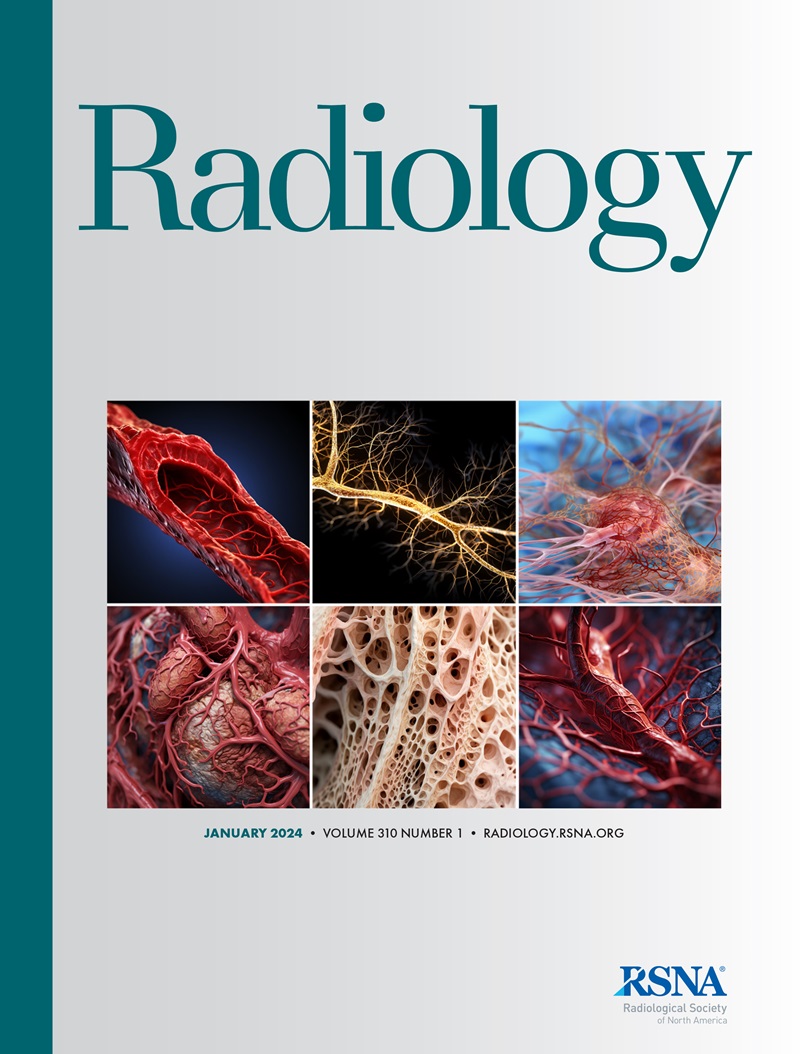Knowledge-Augmented Deep Learning for Segmenting and Detecting Cerebral Aneurysms With CT Angiography: A Multicenter Study.
IF 12.1
1区 医学
Q1 RADIOLOGY, NUCLEAR MEDICINE & MEDICAL IMAGING
Jianyong Wei, Xinyu Song, Xiaoer Wei, Zhiwen Yang, Lisong Dai, Mengfei Wang, Zheng Sun, Yidong Jin, Chune Ma, Chunhong Hu, Xueqian Xie, Zhenghan Yang, Yonggao Zhang, Fajin Lv, Jie Lu, Yueqi Zhu, Yuehua Li
求助PDF
{"title":"Knowledge-Augmented Deep Learning for Segmenting and Detecting Cerebral Aneurysms With CT Angiography: A Multicenter Study.","authors":"Jianyong Wei, Xinyu Song, Xiaoer Wei, Zhiwen Yang, Lisong Dai, Mengfei Wang, Zheng Sun, Yidong Jin, Chune Ma, Chunhong Hu, Xueqian Xie, Zhenghan Yang, Yonggao Zhang, Fajin Lv, Jie Lu, Yueqi Zhu, Yuehua Li","doi":"10.1148/radiol.233197","DOIUrl":null,"url":null,"abstract":"<p><p>Background Deep learning (DL) could improve the labor-intensive, challenging processes of diagnosing cerebral aneurysms but requires large multicenter data sets. Purpose To construct a DL model using a multicenter data set for accurate cerebral aneurysm segmentation and detection on CT angiography (CTA) images and to compare its performance with radiology reports. Materials and Methods Consecutive head or head and neck CTA images of suspected unruptured cerebral aneurysms were gathered retrospectively from eight hospitals between February 2018 and October 2021 for model development. An external test set with reference standard digital subtraction angiography (DSA) scans was obtained retrospectively from one of the eight hospitals between February 2022 and February 2023. Radiologists (reference standard) assessed aneurysm segmentation, while model performance was evaluated using the Dice similarity coefficient (DSC). The model's aneurysm detection performance was assessed by sensitivity and comparing areas under the receiver operating characteristic curves (AUCs) between the model and radiology reports in the DSA data set with use of the DeLong test. Results Images from 6060 patients (mean age, 56 years ± 12 [SD]; 3375 [55.7%] female) were included for model development (training: 4342; validation: 1086; and internal test set: 632). Another 118 patients (mean age, 59 years ± 14; 79 [66.9%] female) were included in an external test set to evaluate performance based on DSA. The model achieved a DSC of 0.87 for aneurysm segmentation performance in the internal test set. Using DSA, the model achieved 85.7% (108 of 126 aneurysms [95% CI: 78.1, 90.1]) sensitivity in detecting aneurysms on per-vessel analysis, with no evidence of a difference versus radiology reports (AUC, 0.93 [95% CI: 0.90, 0.95] vs 0.91 [95% CI: 0.87, 0.94]; <i>P</i> = .67). Model processing time from reconstruction to detection was 1.76 minutes ± 0.32 per scan. Conclusion The proposed DL model could accurately segment and detect cerebral aneurysms at CTA with no evidence of a significant difference in diagnostic performance compared with radiology reports. © RSNA, 2024 <i>Supplemental material is available for this article.</i> See also the editorial by Payabvash in this issue.</p>","PeriodicalId":20896,"journal":{"name":"Radiology","volume":null,"pages":null},"PeriodicalIF":12.1000,"publicationDate":"2024-08-01","publicationTypes":"Journal Article","fieldsOfStudy":null,"isOpenAccess":false,"openAccessPdf":"","citationCount":"0","resultStr":null,"platform":"Semanticscholar","paperid":null,"PeriodicalName":"Radiology","FirstCategoryId":"3","ListUrlMain":"https://doi.org/10.1148/radiol.233197","RegionNum":1,"RegionCategory":"医学","ArticlePicture":[],"TitleCN":null,"AbstractTextCN":null,"PMCID":null,"EPubDate":"","PubModel":"","JCR":"Q1","JCRName":"RADIOLOGY, NUCLEAR MEDICINE & MEDICAL IMAGING","Score":null,"Total":0}
引用次数: 0
引用
批量引用
Abstract
Background Deep learning (DL) could improve the labor-intensive, challenging processes of diagnosing cerebral aneurysms but requires large multicenter data sets. Purpose To construct a DL model using a multicenter data set for accurate cerebral aneurysm segmentation and detection on CT angiography (CTA) images and to compare its performance with radiology reports. Materials and Methods Consecutive head or head and neck CTA images of suspected unruptured cerebral aneurysms were gathered retrospectively from eight hospitals between February 2018 and October 2021 for model development. An external test set with reference standard digital subtraction angiography (DSA) scans was obtained retrospectively from one of the eight hospitals between February 2022 and February 2023. Radiologists (reference standard) assessed aneurysm segmentation, while model performance was evaluated using the Dice similarity coefficient (DSC). The model's aneurysm detection performance was assessed by sensitivity and comparing areas under the receiver operating characteristic curves (AUCs) between the model and radiology reports in the DSA data set with use of the DeLong test. Results Images from 6060 patients (mean age, 56 years ± 12 [SD]; 3375 [55.7%] female) were included for model development (training: 4342; validation: 1086; and internal test set: 632). Another 118 patients (mean age, 59 years ± 14; 79 [66.9%] female) were included in an external test set to evaluate performance based on DSA. The model achieved a DSC of 0.87 for aneurysm segmentation performance in the internal test set. Using DSA, the model achieved 85.7% (108 of 126 aneurysms [95% CI: 78.1, 90.1]) sensitivity in detecting aneurysms on per-vessel analysis, with no evidence of a difference versus radiology reports (AUC, 0.93 [95% CI: 0.90, 0.95] vs 0.91 [95% CI: 0.87, 0.94]; P = .67). Model processing time from reconstruction to detection was 1.76 minutes ± 0.32 per scan. Conclusion The proposed DL model could accurately segment and detect cerebral aneurysms at CTA with no evidence of a significant difference in diagnostic performance compared with radiology reports. © RSNA, 2024 Supplemental material is available for this article. See also the editorial by Payabvash in this issue.
利用 CT 血管造影分割和检测脑动脉瘤的知识增强型深度学习:一项多中心研究。
背景 深度学习(Deep Learning,DL)可以改善脑动脉瘤诊断这一劳动密集型、具有挑战性的过程,但需要大型多中心数据集。目的 利用多中心数据集构建一个深度学习模型,用于准确分割和检测 CT 血管造影(CTA)图像上的脑动脉瘤,并将其性能与放射学报告进行比较。材料与方法 在2018年2月至2021年10月期间,从8家医院回顾性收集了疑似未破裂脑动脉瘤的连续头颅或头颈部CTA图像,用于模型开发。2022 年 2 月至 2023 年 2 月期间,从八家医院中的一家医院回顾性地获得了参考标准数字减影血管造影(DSA)扫描的外部测试集。放射科医生(参考标准)对动脉瘤分割进行评估,同时使用戴斯相似系数(DSC)对模型性能进行评估。通过灵敏度评估模型的动脉瘤检测性能,并使用 DeLong 检验比较 DSA 数据集中模型与放射学报告之间的接收器工作特征曲线下面积 (AUC)。结果 6060 名患者(平均年龄 56 岁 ± 12 [SD];3375 [55.7%] 女性)的图像被纳入模型开发(训练:4342;验证:1086;内部测试集:632)。另外 118 名患者(平均年龄 59 岁 ± 14 岁;女性 79 [66.9%])被纳入外部测试集,以评估基于 DSA 的性能。在内部测试集中,该模型的动脉瘤分割性能 DSC 为 0.87。使用 DSA,该模型在每个血管分析中检测动脉瘤的灵敏度达到 85.7%(126 个动脉瘤中的 108 个 [95% CI:78.1, 90.1]),与放射学报告相比没有证据表明有差异(AUC, 0.93 [95% CI:0.90, 0.95] vs 0.91 [95% CI:0.87, 0.94];P = 0.67)。每次扫描从重建到检测的模型处理时间为 1.76 分钟 ± 0.32 分钟。结论 拟议的 DL 模型可在 CTA 中准确分割和检测脑动脉瘤,与放射学报告相比,诊断性能无明显差异。© RSNA, 2024 这篇文章有补充材料。另请参阅本期 Payabvash 的社论。
本文章由计算机程序翻译,如有差异,请以英文原文为准。

 求助内容:
求助内容: 应助结果提醒方式:
应助结果提醒方式:


